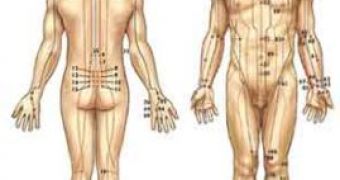A recent German study found that acupuncture traditional practice is very beneficial for individuals with osteoarthritis, by improving condition's symptoms and considerably reducing pains caused by an inflamed hip or knee joint. Given the overall results, researchers at the Charit? University Medical Center - who carried out the study - advised osteoarthritis patients to add acupuncture sessions to their routine care if they want to eliminate daily, persistent pain.
Writing in the Arthritis & Rheumatism Journal, lead researcher Claudia M. Witt, M.D and her colleagues pinpointed: "In patients with chronic pain due to osteoarthritis of the knee or hip who were receiving routine primary care, addition of acupuncture to the treatment regimen resulted in a clinically relevant and persistent benefit."
Acupuncture is an ancient Chinese medical practice which focuses on the vital, universal flow of Qi/Chi energy in order to relieve pain and treat a wide range of diseases. The principle on which Acupuncture works is related to the belief that there is a unity in the universe and nothing should be seen as a separate entity, as we are all parts of the supreme entity that is Nature. Therefore, all parts of our body should be seen as an entity and treated as such - as a whole, not partially.
According to Chinese principles, the flux of Chi flows within our bodies through 12 'highways', called meridians. The 12 meridians cover our body from head to toes and usually correspond to the functions of the main bodily organs and also to certain mental and emotional features. There are also two other meridians which are "odder", as they are assigned to arteries in the body's axis. When using needles to treat patients, acupuncture specialists try to free the obstructions which occur in the meridians and let the Chi energy of life flow continuously throughout our body.
The study was conducted on 3,633 patients with osteoporosis, who experienced continuous, acute pain in the knee or hip area of the body due to inflamed joints. Out of all volunteers with an average age of about 62, 357 subjects were included in the treatment group and underwent 15 acupuncture sessions throughout a 4 month period of time. On the other hand, other 355 subjects were included in the control group and received no other treatment than routine care. The remaining number of volunteers took up acupuncture sessions, too.
Overall results of the study showed that patients in the treatment group, who underwent acupuncture sessions, greatly benefited from taking up the traditional Chinese practice. Subjects in this group experienced a considerable reduction in their persistent pains caused by the inflammation of joints.
In an editorial accompanying the report in the Arthritis & Rheumatism Journal, Tao Liu, M.D., and Chen Liu, M.D., of the 2nd Teaching Hospital of Jilin University in Changchun, Jilin, China wrote: "Given that the biologic mechanism of acupuncture is still unclear, the study by Witt et al furthers our understanding of acupuncture and adds to the accumulated evidence supporting its efficacy. Such evidence warrants extensive use of acupuncture in various chronic pain conditions.
As a pragmatic clinical trial comparing acupuncture in addition to routine care with routine care alone in patients with pain due to OA of the knee or hip, this study reflects as closely as possible the conditions of daily medical practice, and, as the authors point out, maximizes external validity and clinical relevance."

 14 DAY TRIAL //
14 DAY TRIAL //